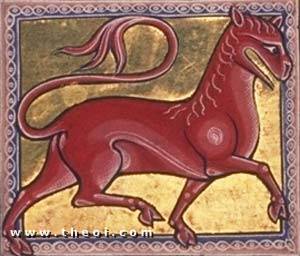LEUKROKOTTAS
Greek Name
Λευκροκοττας
Λευκροκοτται
Transliteration
Leukrokottas
Leukrokottai
Latin Spelling
Leucrocotta Leucrocota
Leucrocottae
Translation
Yellow-white?
(leukos, krokôtos)

THE LEUKROKOTTAS (Leucrocotta) was a fantastic creature with the body of a stag, the neck of a lion, cloven hooves, and a wide mouth with a sharp, bony ridge in place of teeth. It had the ability to imitate the voices of men to lure prey.
The creature was probably derived from ancient travellers' accounts of the hyena.
CLASSICAL LITERATURE QUOTES
Ctesias, Indica (summary from Photius, Myriobiblon 72) (trans. Freese) (Greek historian C4th B.C.) :
"In Aithiopia (Ethiopia) there is an animal called Krokottas (Crocotta), vulgarly Kynolykos (Cynolycus, Dog-Wolf), of amazing strength. It is said to imitate the human voice, to call men by name at night, and to devour those who approach it. It is as brave as a lion, as swift as a horse, and as strong as a bull. It cannot be overcome by any weapon of steel."
Aelian, On Animals 7. 22 (trans. Scholfield) (Greek natural history C2nd A.D.) :
"It seems that the Hyaina (Hyena) and the Korokottai (Corocottae), as they call it, are viciously clever animals. At any rate the Hyaina prowls about cattle-folds by night and imitates men vomiting. And at the sound dogs come up, thinking it is a man. Whereupon it seizes and devours them. I shall now relate the villainy of the Korokottai, of which I have actually heard. It conceals itself in thickets and then listens to woodcutters calling one another by name, and even to anything they say. And then it imitates their voices and speaks (though the story may be fabulous) with a voice that sounds human at any rate, calling out the name which it has heard. And the man who has been called approaches: the animal withdraws and calls again : the man follows the voice all the more. But when it has drawn him away from his fellow-workers and has got him alone, it seizes him and kills him and then makes a meal of him after luring him on with its call."
Pliny the Elder, Natural History 8. 72 (trans. Rackham) (Roman encyclopedia C1st A.D.) :
"Aethiopia (Ethiopia) produces . . . many monstrosities : . . . the Leucrocota, swiftest of wild beasts, about the size of an ass, with a stag's haunches, a lion's neck, tail and breast, badger's head, cloven hoof, mouth opening right back to the ears, and ridges of bone in place of rows of teeth--this animals is reported to imitate the voices of human beings."
Pliny the Elder, Natural History 8. 107 :
"When crossed with this race of animals [i.e. hyenas] the Aethiopian (Ethiopian) lioness gives birth to the Corocotta, that mimics the voices of men and cattle. It has an unbroken ridge of bone in each jaw, forming a continuous tooth without any gum, which to prevent its being blunted by contact with the opposite jaw is shut up in a sort of case. Juba states that in Aethiopia the Mantichora (Manticore) also mimics human speech."
ALTERNATE NAME SPELLINGS
Greek Name
Κοροκοττας Κοροκοτται
Κροκοττας Κροκοτται
Κροκουτας Κροκουται
Κυνολυκος Κυνολυκοι
Transliteration
Korokottas, Korokottai
Krokottas, Krokottai
Krokoutas, Krokoutai
Kynolykos, Kynolykoi
Latin Spelling
Corocottas, Corocottae
Crocotta, Crocottae
Crocuta, Crocutae
Cynolycus, Cynolyci
Translation
Saffron-colour (krokôtos)
id.
id.
Dog-Wolf (kyôn, lykos)
SOURCES
GREEK
- Ctesias, Indica - Greek History C5th B.C.
- Aelian, On Animals - Greek Natural History C2nd - 3rd A.D.
ROMAN
- Pliny the Elder, Natural History - Latin Encyclopedia C1st A.D.
BYZANTINE
- Photius, Myriobiblon - Byzantine Greek Scholar C9th A.D.
BIBLIOGRAPHY
A complete bibliography of the translations quoted on this page.